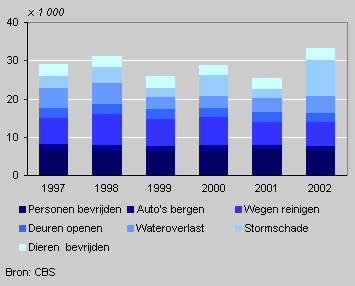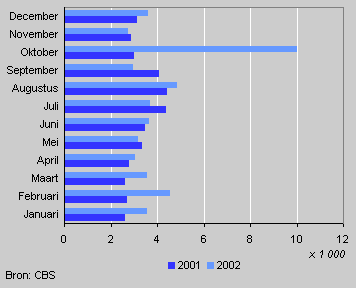Record number of call-outs fire services

Municipal fire services received 56 thousand requests for technical assistance in 2002. This is ten thousand more than in 2001 and the highest number ever. Six thousand of the requests were false alarms.
Storm damage helped set new record
More than one quarter of the call-outs were for flooding and storm damage. The storm in October 2002 doubled the share of call-outs for storm damage compared with the previous year. Fire services were also often called upon to free or rescue people and cleaning up spills on roads and other grounds.
Cases by type of assistance

In six out of ten cases where they were called out the fire services assisted in emergencies outside buildings. More than half of these were on the roads or other grounds and one in five cases was a car accident. They were called out to 21 thousand emergencies inside buildings, of which 80 percent in residential buildings.
Busy months for fire services
The number of call-outs differed per month. In the month of October 2002 alone they were called out ten thousand times, as a consequence of the severe storm at the end of October. But February (storm) and August (floods), too, were busy months, with nearly five thousand call-outs. November was relatively quiet, with just under three thousand requests for help.
Call-outs per month

More people killed
Cases of assistance in accidents involved nearly 800 fatal victims, nearly 20 percent more than the average for the previous five years. Assistance in these cases often involves recovering the body; one in three deaths occur in car accidents.
Increased assistance in small municipalities in particular
The fire services assisted in twelve thousand cases in the four largest cities, i.e. one quarter of all cases. On average, across the country they assisted three times per thousand inhabitants. Compared with 2001 the relative increase in the number of requests for assistance was larger for small municipalities (42 percent) than in the four big cities (13 percent).
Wim Vissers